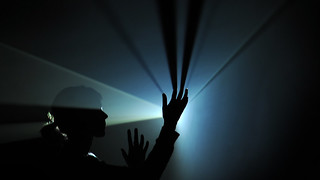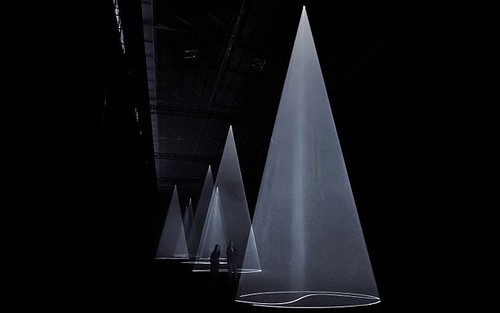While the footage on its own had a great aesthetic effect we decided that a relevant reading played over the top of each video clip would add to it. Each of us took on three rooms for which to find or write a text that we felt connected to the image, or added to or complimented the narrative of the clip. Considering the title of the whole performance was called ‘Safe House’ I looked in U.A. Fanthorpes “Safe As Houses” (( U.A. Fanthorpe (1995) Safe As Houses: Poems by U.A. Fanthorpe. Cornwall: Peterloo Poets – a book of short poems )) . I found that the first stanza of the poem Haunting connected with mood and movement of the CCTV footage of the landing, discussing shadows and ancestors who just passed through. This coupled with the second stanza of the poem Last House created a piece that spoke of shadows in three different senses-the darkness that requires light to be present, the ghost or image of a dead person, and the Shakespearean term for an actor.
“These are the ancestors. The shadow people,
who now and then lean softly from the dark
and stroke on chin or thumb the new generation.
This is their last performance. The delegate yaws doubtfully, as audiences do,
wanting the star to fall… but not until the last reel, at sunset, to the right music.” (( An adaptation of two poems by U.A. Fanthorpe (1995) Safe As Houses: Poems by U.A. Fanthorpe. Cornwall: Peterloo Poets ))
Another of my readings was a piece by David Rattray. His piece spoke of the fragility and ambiguity of existence in a way that complimented the brief existence of each of the life forms in every image.
“Life is a fragile hybrid pulsing, instant by instant, between being and nothingness. Even if every person on earth were to vanish suddenly from time and space, the mere fact of the absence would suffice to make humanity remain identical to what it already was. Absent.” (( Rattray, David (1992) How I Became One of The Invisible. USA: Semiotext p. 204 ))
For my final reading I took the lines of Lady Macbeth in Shakespeare’s Macbeth and used them for the kitchen footage. In this stanza the Lady Macbeth discusses the place of women in the house and how strong the female kind are and this felt attuned to the place of the women in the modern day kitchen.
Installation piece-Kitchen. By Lizzy Hayes, Lauren Hughes, Faye Mcdool
(To view all the installation video clips with voice recordings please visit Lauren Hughes YouTube account on http://www.youtube.com/channel/UC-d_h3abFFc4K36mLaNFaDw?feature=watch )
This was not the only feminist reading we acquired. For two of the other clips we used lines from H. G Wells’ book The Invisible Man but decided to alter the narrative to make them the voice of a woman. Not only was the text relevant to the clips in the text but also to us as CCTV operatives. We were the people who could see everything whilst remaining unseen.
Each video and sound clip was played off of a different screen, on a loop, in synchronisation and in a darkened room. For me the effect was haunting. To sit in the dark having nine different voices speak or whisper nine different pieces of text from varying points in the room felt like I was sat in the dark the centre of the mind of a very thoughtful but confused person. Once again, I felt like I had power beyond my status: not only was I hearing the somewhat disjointed thoughts of various writers, poets and even fellow actors, but I still had the power to see the movements of every other person in the house. My way of overcoming the strange feeling? Play with the power.





